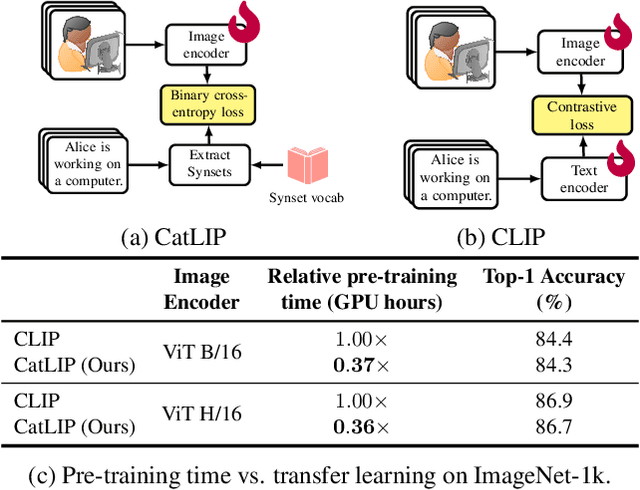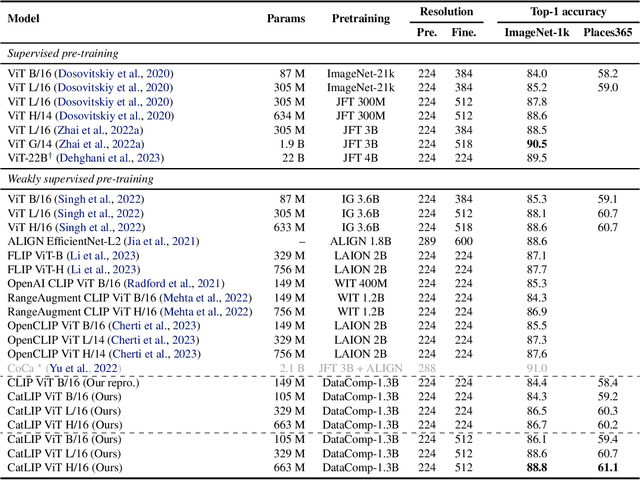Mehrdad Farajtabar
TiC-LM: A Web-Scale Benchmark for Time-Continual LLM Pretraining
Apr 02, 2025Abstract:Large Language Models (LLMs) trained on historical web data inevitably become outdated. We investigate evaluation strategies and update methods for LLMs as new data becomes available. We introduce a web-scale dataset for time-continual pretraining of LLMs derived from 114 dumps of Common Crawl (CC) - orders of magnitude larger than previous continual language modeling benchmarks. We also design time-stratified evaluations across both general CC data and specific domains (Wikipedia, StackExchange, and code documentation) to assess how well various continual learning methods adapt to new data while retaining past knowledge. Our findings demonstrate that, on general CC data, autoregressive meta-schedules combined with a fixed-ratio replay of older data can achieve comparable held-out loss to re-training from scratch, while requiring significantly less computation (2.6x). However, the optimal balance between incorporating new data and replaying old data differs as replay is crucial to avoid forgetting on generic web data but less so on specific domains.
From Dense to Dynamic: Token-Difficulty Driven MoEfication of Pre-Trained LLMs
Feb 17, 2025Abstract:Training large language models (LLMs) for different inference constraints is computationally expensive, limiting control over efficiency-accuracy trade-offs. Moreover, once trained, these models typically process tokens uniformly, regardless of their complexity, leading to static and inflexible behavior. In this paper, we introduce a post-training optimization framework, DynaMoE, that adapts a pre-trained dense LLM to a token-difficulty-driven Mixture-of-Experts model with minimal fine-tuning cost. This adaptation makes the model dynamic, with sensitivity control to customize the balance between efficiency and accuracy. DynaMoE features a token-difficulty-aware router that predicts the difficulty of tokens and directs them to the appropriate sub-networks or experts, enabling larger experts to handle more complex tokens and smaller experts to process simpler ones. Our experiments demonstrate that DynaMoE can generate a range of adaptive model variants of the existing trained LLM with a single fine-tuning step, utilizing only $10B$ tokens, a minimal cost compared to the base model's training. Each variant offers distinct trade-offs between accuracy and performance. Compared to the baseline post-training optimization framework, Flextron, our method achieves similar aggregated accuracy across downstream tasks, despite using only $\frac{1}{9}\text{th}$ of their fine-tuning cost.
SALSA: Soup-based Alignment Learning for Stronger Adaptation in RLHF
Nov 04, 2024



Abstract:In Large Language Model (LLM) development, Reinforcement Learning from Human Feedback (RLHF) is crucial for aligning models with human values and preferences. RLHF traditionally relies on the Kullback-Leibler (KL) divergence between the current policy and a frozen initial policy as a reference, which is added as a penalty in policy optimization algorithms like Proximal Policy Optimization (PPO). While this constraint prevents models from deviating too far from the initial checkpoint, it limits exploration of the reward landscape, reducing the model's ability to discover higher-quality solutions. As a result, policy optimization is often trapped in a narrow region of the parameter space, leading to suboptimal alignment and performance. This paper presents SALSA (Soup-based Alignment Learning for Stronger Adaptation), a novel approach designed to overcome these limitations by creating a more flexible and better located reference model through weight-space averaging of two independent supervised fine-tuned (SFT) models. This model soup allows for larger deviation in KL divergence and exploring a promising region of the solution space without sacrificing stability. By leveraging this more robust reference model, SALSA fosters better exploration, achieving higher rewards and improving model robustness, out-of-distribution generalization, and performance. We validate the effectiveness of SALSA through extensive experiments on popular open models (Llama2-7B, Mistral-7B, and Gemma-2B) across various benchmarks (MT-Bench, Arena-Hard, UltraFeedback), where it consistently surpasses PPO by fostering deeper exploration and achieving superior alignment in LLMs.
Computational Bottlenecks of Training Small-scale Large Language Models
Oct 25, 2024



Abstract:While large language models (LLMs) dominate the AI landscape, Small-scale large Language Models (SLMs) are gaining attention due to cost and efficiency demands from consumers. However, there is limited research on the training behavior and computational requirements of SLMs. In this study, we explore the computational bottlenecks of training SLMs (up to 2B parameters) by examining the effects of various hyperparameters and configurations, including GPU type, batch size, model size, communication protocol, attention type, and the number of GPUs. We assess these factors on popular cloud services using metrics such as loss per dollar and tokens per second. Our findings aim to support the broader adoption and optimization of language model training for low-resource AI research institutes.
GSM-Symbolic: Understanding the Limitations of Mathematical Reasoning in Large Language Models
Oct 07, 2024



Abstract:Recent advancements in Large Language Models (LLMs) have sparked interest in their formal reasoning capabilities, particularly in mathematics. The GSM8K benchmark is widely used to assess the mathematical reasoning of models on grade-school-level questions. While the performance of LLMs on GSM8K has significantly improved in recent years, it remains unclear whether their mathematical reasoning capabilities have genuinely advanced, raising questions about the reliability of the reported metrics. To address these concerns, we conduct a large-scale study on several SOTA open and closed models. To overcome the limitations of existing evaluations, we introduce GSM-Symbolic, an improved benchmark created from symbolic templates that allow for the generation of a diverse set of questions. GSM-Symbolic enables more controllable evaluations, providing key insights and more reliable metrics for measuring the reasoning capabilities of models.Our findings reveal that LLMs exhibit noticeable variance when responding to different instantiations of the same question. Specifically, the performance of all models declines when only the numerical values in the question are altered in the GSM-Symbolic benchmark. Furthermore, we investigate the fragility of mathematical reasoning in these models and show that their performance significantly deteriorates as the number of clauses in a question increases. We hypothesize that this decline is because current LLMs cannot perform genuine logical reasoning; they replicate reasoning steps from their training data. Adding a single clause that seems relevant to the question causes significant performance drops (up to 65%) across all state-of-the-art models, even though the clause doesn't contribute to the reasoning chain needed for the final answer. Overall, our work offers a more nuanced understanding of LLMs' capabilities and limitations in mathematical reasoning.
CatLIP: CLIP-level Visual Recognition Accuracy with 2.7x Faster Pre-training on Web-scale Image-Text Data
Apr 24, 2024



Abstract:Contrastive learning has emerged as a transformative method for learning effective visual representations through the alignment of image and text embeddings. However, pairwise similarity computation in contrastive loss between image and text pairs poses computational challenges. This paper presents a novel weakly supervised pre-training of vision models on web-scale image-text data. The proposed method reframes pre-training on image-text data as a classification task. Consequently, it eliminates the need for pairwise similarity computations in contrastive loss, achieving a remarkable $2.7\times$ acceleration in training speed compared to contrastive learning on web-scale data. Through extensive experiments spanning diverse vision tasks, including detection and segmentation, we demonstrate that the proposed method maintains high representation quality. Our source code along with pre-trained model weights and training recipes is available at \url{https://github.com/apple/corenet}.
Weight subcloning: direct initialization of transformers using larger pretrained ones
Dec 14, 2023



Abstract:Training large transformer models from scratch for a target task requires lots of data and is computationally demanding. The usual practice of transfer learning overcomes this challenge by initializing the model with weights of a pretrained model of the same size and specification to increase the convergence and training speed. However, what if no pretrained model of the required size is available? In this paper, we introduce a simple yet effective technique to transfer the knowledge of a pretrained model to smaller variants. Our approach called weight subcloning expedites the training of scaled-down transformers by initializing their weights from larger pretrained models. Weight subcloning involves an operation on the pretrained model to obtain the equivalent initialized scaled-down model. It consists of two key steps: first, we introduce neuron importance ranking to decrease the embedding dimension per layer in the pretrained model. Then, we remove blocks from the transformer model to match the number of layers in the scaled-down network. The result is a network ready to undergo training, which gains significant improvements in training speed compared to random initialization. For instance, we achieve 4x faster training for vision transformers in image classification and language models designed for next token prediction.
LLM in a flash: Efficient Large Language Model Inference with Limited Memory
Dec 12, 2023



Abstract:Large language models (LLMs) are central to modern natural language processing, delivering exceptional performance in various tasks. However, their intensive computational and memory requirements present challenges, especially for devices with limited DRAM capacity. This paper tackles the challenge of efficiently running LLMs that exceed the available DRAM capacity by storing the model parameters on flash memory but bringing them on demand to DRAM. Our method involves constructing an inference cost model that harmonizes with the flash memory behavior, guiding us to optimize in two critical areas: reducing the volume of data transferred from flash and reading data in larger, more contiguous chunks. Within this flash memory-informed framework, we introduce two principal techniques. First, "windowing'" strategically reduces data transfer by reusing previously activated neurons, and second, "row-column bundling", tailored to the sequential data access strengths of flash memory, increases the size of data chunks read from flash memory. These methods collectively enable running models up to twice the size of the available DRAM, with a 4-5x and 20-25x increase in inference speed compared to naive loading approaches in CPU and GPU, respectively. Our integration of sparsity awareness, context-adaptive loading, and a hardware-oriented design paves the way for effective inference of LLMs on devices with limited memory.
Label-efficient Training of Small Task-specific Models by Leveraging Vision Foundation Models
Nov 30, 2023



Abstract:Large Vision Foundation Models (VFMs) pretrained on massive datasets exhibit impressive performance on various downstream tasks, especially with limited labeled target data. However, due to their high memory and compute requirements, these models cannot be deployed in resource constrained settings. This raises an important question: How can we utilize the knowledge from a large VFM to train a small task-specific model for a new target task with limited labeled training data? In this work, we answer this question by proposing a simple and highly effective task-oriented knowledge transfer approach to leverage pretrained VFMs for effective training of small task-specific models. Our experimental results on four target tasks under limited labeled data settings show that the proposed knowledge transfer approach outperforms task-agnostic VFM distillation, web-scale CLIP pretraining and supervised ImageNet pretraining by 1-10.5%, 2-22% and 2-14%, respectively. We also show that the dataset used for transferring knowledge has a significant effect on the final target task performance, and propose an image retrieval-based approach for curating effective transfer sets.
TiC-CLIP: Continual Training of CLIP Models
Oct 24, 2023



Abstract:Keeping large foundation models up to date on latest data is inherently expensive. To avoid the prohibitive costs of constantly retraining, it is imperative to continually train these models. This problem is exacerbated by the lack of any large scale continual learning benchmarks or baselines. We introduce the first set of web-scale Time-Continual (TiC) benchmarks for training vision-language models: TiC-DataCompt, TiC-YFCC, and TiC-RedCaps with over 12.7B timestamped image-text pairs spanning 9 years (2014--2022). We first use our benchmarks to curate various dynamic evaluations to measure temporal robustness of existing models. We show OpenAI's CLIP (trained on data up to 2020) loses $\approx 8\%$ zero-shot accuracy on our curated retrieval task from 2021--2022 compared with more recently trained models in OpenCLIP repository. We then study how to efficiently train models on time-continuous data. We demonstrate that a simple rehearsal-based approach that continues training from the last checkpoint and replays old data reduces compute by $2.5\times$ when compared to the standard practice of retraining from scratch.
 Add to Chrome
Add to Chrome Add to Firefox
Add to Firefox Add to Edge
Add to Edge